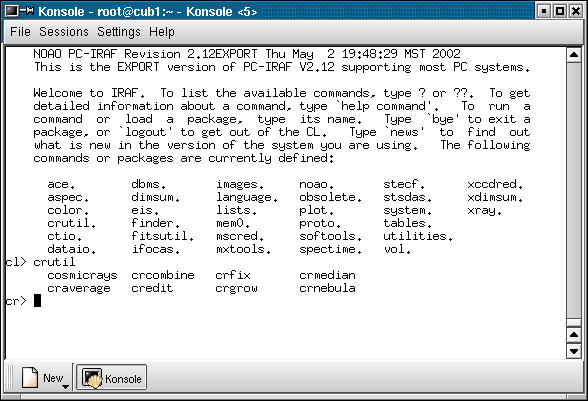Contents
Previous
Next
COSMIC RAY REMOVAL UTILITY PACKAGE
Version : 1.4
Author(s) : Frank Valdes (fvaldes@noao.edu)
License : AURA
Website : http://iraf.noao.edu
Disk space required for installation is 1.68 Mb
Summary
The cosmic ray package provides tools for identifying and removing
cosmic
rays in images. The tasks are:
cosmicrays - Remove cosmic rays using flux ratio algorithm
craverage - Detect CRs against average and avoid objects
crcombine - Combine multiple exposures to eliminate cosmic rays
credit - Interactively edit cosmic rays using an image display
crfix - Fix cosmic rays in images using cosmic ray masks
crgrow - Grow cosmic rays in cosmic ray masks
crmedian - Detect and replace cosmic rays with median filter
crnebula - Detect and replace cosmic rays in nebular data
The best way to remove cosmic rays is using multiple exposures of
the same
field. When this is done the task crcombine is used to combine the
exposures into a final single image with cosmic rays removed. The
images
are scaled (if necessary) to a common data level either by
multiplicative
scaling, an additive background offset, or some combination of
both.
Cosmic rays are then found as pixels which differ by some
statistical
amount away for the average or median of the data.
A median is the simplest way to remove cosmic rays. This is an
option
with crcombine. But this does not make optimal use of the data.
An average of the pixels remaining after some rejection operation
is better.
If the noise characteristics of the data can be described by a gain
and
read noise then cosmic rays can be optimally rejected using the
"crreject" algorithm. This works on two or more images. There are
a number of other rejection algorithms which can be used as
described in
the task help.
The rest of the tasks in the package are used when only a single
exposure
is available. These include interactive editing with credit. The
replacement algorithms in this task may also be used
non-interactively if
you have a list of pixel coordinates as input. Other tasks
automatically
identifying pixels which are significantly higher than surrounding
pixels.
Screenshots

Contents
Previous
Next

